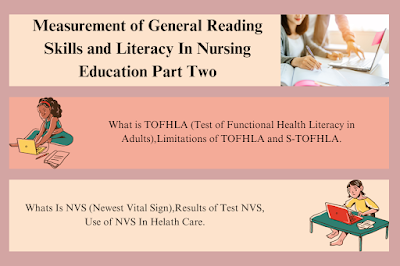The Measurement of General Reading Skills and Literacy In Nursing Education. It is generally measured by the ability to understand a short, simple statement about everyday life. Literacy generally also includes numeracy, and the measurement may involve a simple numeracy assessment.
Measurement of General Reading Skills and Literacy In Nursing Education
Measuring general literacy skills in nursing education involves assessing students’ ability to understand and apply health and healthcare information. This can be achieved through a variety of tools and methods, including standardized tests, observational assessments, and review of student work. The goal is to ensure that students have the literacy skills necessary to communicate effectively with patients, understand clinical information, and make informed healthcare decisions.
Reading Skills and Literacy In Nursing Education
Literacy skills are fundamental in nursing education for effective communication, evidence-based practice, and patient care. Nurses must be able to read and understand complex medical information, research articles, and patient instructions. They must also be able to critically analyze and process information to make informed decisions and ensure optimal patient care.
TOFHLA (Test of Functional Health Literacy in Adults)
TOFHLA is a functional literacy assessment tool that evaluates the literacy skills of adults in healthcare settings. The instrument measures functional literacy based on the assumption that more than just classroom reading skills are required to adequately understand and use the healthcare system.
Overview:
The TOFHLA, developed in the mid-1990s, is a comprehensive tool designed to measure a patient’s functional health literacy using real-world materials such as prescription labels, appointment slips, and consent forms. It evaluates both reading comprehension and numeracy skills, providing insights into a patient’s ability to understand and use health-related information.
Components:
- Reading Comprehension: Assesses the ability to understand written health information by presenting patients with passages and questions.
- Numeracy: Evaluates the ability to interpret numerical information, such as dosage instructions and appointment dates.
Administration and Versions:
- Time: Approximately 20 minutes.
- Languages: Available in English and Spanish (TOFHLA-S).
- Access: The TOFHLA and its directions can be accessed through Peppercorn Books.
Limitations of TOFHLA and S-TOFHLA:
- Focus on Structure: While useful for assessing comprehension, readability formulas and standardized tests like TOFHLA and S-TOFHLA focus on structure rather than content quality. This means they might not fully capture how well a patient can understand or use health information in real-world settings.
- Style of Writing: These tests do not address the conversational quality of written materials. Patient educators should use readability and comprehension tests as guides rather than strict rules, aiming for clear, practical, and patient-centered communication.
S-TOFHLA (Short Test of Functional Health Literacy in Adults)
Overview:
The S-TOFHLA is an abbreviated version of the TOFHLA, designed to provide a quicker assessment of functional health literacy.
Components:
- Time: Approximately 12 minutes.
- Reliability and Validity: Demonstrated to be reliable and valid for assessing functional health literacy. It is a practical measure for identifying individuals who may need additional help achieving learning goals.
NVS (Newest Vital Sign)
Overview:
The NVS is a rapid screening tool designed to identify individuals at risk for low health literacy. It involves evaluating a patient’s ability to understand and use information from an ice cream nutrition label.
Components:
- Task: Patients are shown a nutritional label and asked a series of questions related to it. This evaluates both reading comprehension and numeracy.
- Time: Takes about 3 minutes to administer.
Scoring and Results:
- Scoring: Each correct answer earns one point.
- Categories:
- 1-2 Points: Likelihood of limited literacy.
- 3-4 Points: Possibility of limited literacy.
- 5-6 Points: Adequate literacy.
Use in Health Care:
- Administration: Recommended to be administered during routine clinical activities, such as when obtaining vital signs.
- Languages: Available in both English and Spanish.
- Comparison: Early evaluations indicate that the NVS is comparable to other health literacy tests like REALM and S-TOFHLA, making it a suitable tool for primary care settings.
- Additional Resources: More information and access to the tool are available on the Pfizer Health Literacy website.
Summary:
Both TOFHLA and NVS are valuable tools for assessing health literacy. TOFHLA provides a comprehensive measure of reading and numeracy skills with a longer administration time, while the NVS offers a quick, practical screening method. Each tool has its strengths and limitations, and their use in healthcare settings can significantly enhance the effectiveness of patient education by identifying literacy needs and ensuring that educational materials are appropriately tailored to patients’ comprehension levels.
Read More:
https://nurseseducator.com/didactic-and-dialectic-teaching-rationale-for-team-based-learning/
https://nurseseducator.com/high-fidelity-simulation-use-in-nursing-education/
First NCLEX Exam Center In Pakistan From Lahore (Mall of Lahore) to the Global Nursing
Categories of Journals: W, X, Y and Z Category Journal In Nursing Education
AI in Healthcare Content Creation: A Double-Edged Sword and Scary
Social Links:
https://www.facebook.com/nurseseducator/
https://www.instagram.com/nurseseducator/
